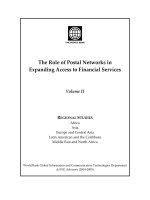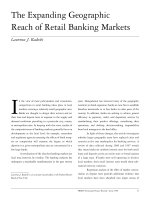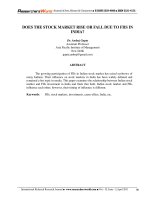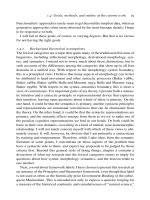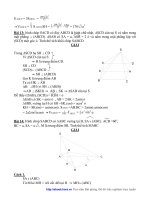The Rise and Fall of Abacus Banking in Japan and China phần 2 docx
Bạn đang xem bản rút gọn của tài liệu. Xem và tải ngay bản đầy đủ của tài liệu tại đây (139.46 KB, 20 trang )
Acknowledgments
Part of this book was completed during Panos Mourdoukoutas’ stay at
Nagoya University and Chukyo University. The authors are indebted to
professors Akira Yakita of Chukyo University, Tadashi Yagi of Doshisha
University, and Shogo Kimura of Nagoya University, and to Mr. Atsushi
Nishiyama and Mr. Katsuya Miyoshi.
The Rise and Fall
of Abacus Banking
in Japan and China
Chapter 1
Beyond Non-performing
Assets: Abacus Banking
In the years 1986 to 1991, Japan generated a wave of hyperliquidity.
This extraordinary surge of money created one of the great collective
madnesses of world financial experience, a speculative excess that
created what came to be known as the bubble economy, an event
that Forbes magazine in 1987 identified as comparable with the no-
torious Dutch tulip bulb craze of the 17th century or the South Sea
bubble of the 18th.
—Peter Hartcher
1
For decades, Japan’s robust economy was the envy of the world. Her
export-led industrialization growth strategy served as a role model for
growth and prosperity for the emerging economies of nearby Southeast
Asia and elsewhere around the world. Her labor institutions and man-
agement practices became case studies in MBA programs around the
world. Her bureaucrats at the legendary Ministry of International Trade
and Industry (MITI) and the Ministry of Finance (MOF) dreamed of tak-
ing on the world’s largest economy, the United States, especially in the
second half of the roaring 1980s, in the ‘‘bubble years’’ when the U.S.
and European economies remained stagnant. In fact, according to some
Japanese politicians, the country’s modern economic model, especially
management organization, was an alternative to the antiquated U.S. ec-
onomic model:
2 The Rise and Fall of Abacus Banking in Japan and China
The Japanese way of doing things seems to fit this stage of history better The
Japanese system puts emphasis on stability and teamwork and has distinct ad-
vantages. It fits the requirements of the times, particularly of this stage of tech-
nological development.
2
As we enter the new millennium, Japan’s sluggish economy is no
longer the envy of the world. Her export-led industrialization strategy
no longer serves as a role model for the emerging economies in Asia or
elsewhere, but as a bad lesson, an example of crony capitalism doomed
to economic bubbles and bursts. Her labor institutions and management
are losing their popularity with MBA programs around the world. Her
bureaucrats at MITI and MOF face the anger and the dismay of their
U.S. counterparts for failing to address the economic problems of the
country, a failure that has turned into a threat for the global economy.
Indeed, Japan’s economic performance since the early 1990s, a period of
world recovery and robust growth for the U.S. economy, has been dis-
appointing. Real GDP growth fell from 6.1 percent in 1988 to 3.8 percent
in 1991, falling into negative territory by 1994. After a 3.5 percent re-
bound in 1996, it slid into negative territory again in 1998 and expected
to grow by 0.6 percent in 1999. In the meantime, the Nikkei stock average
dropped from 40,000 in 1989 to below 13,000 by 1998 before returning
to 17,000 by mid-1999, while real estate prices returned to their pre-1985
levels.
At the core of Japan’s economic woes is a prolonged banking crisis, as
manifested in the billions of dollars of non-performing loans which have
yet to be written off. Even as recently as 1998, in spite of several gov-
ernment packages, Tokyo Mitsubishi Bank, DKB, Sumitomo Bank, and
Sakura have disposed of less than half of their non-performing assets
(see Exhibit 1.1).
Japan’s banking crisis is also manifested in a credit crunch that has
neutralized monetary policy (i.e., aggressive monetary easing has failed
to expand lending to allying business sectors of the economy and resolve
the banking crisis). As an Economist report puts it, ‘‘The sickness of Ja-
pan’s banks makes any macroeconomic approach to the problem, fiscal
or monetary, irrelevant; the country’s productive potential, not merely
its ability to mobilize demand, is collapsing.’’
3
Indeed, since 1990, the
Bank of Japan (BOJ) has launched an unprecedented expansionary mon-
etary policy, lowering the discount rate from 5.5 percent to 0.25 percent
without avail. At the same time, the Japanese government has launched
an aggressive fiscal stimulus package that poured billions of yen into
Exhibit 1.1
Non-performing Loans for Selected Japanese Banks in 1998
4 The Rise and Fall of Abacus Banking in Japan and China
public projects without avail,
4
and the 1996 launching of a Japanese ver-
sion of the U.S. Resolution Trust Corporation—the Japan Resolution
Trust Corporation (JRTC)—has failed to produce any meaningful results.
Burdened with billions of dollars of non-performing assets and striv-
ing to meet the Bank International Settlement (BIS) requirements, Japa-
nese banks have opted to invest in domestic and foreign fixed income
securities rather than to extend new loans.
5
As Sato puts it:
Weakened to the point of collapse in some cases, Japanese banks have been
unable to provide sufficient capital, in the form of loans, to Japanese companies,
as they work instead to meet the necessary BIS capital ratios by cutting back on
their assets and refusing to renew loans.
6
The bank’s reluctance to extend new loans now dried up financing, es-
pecially for start-up enterprises. As McAlinn states:
The magnitude of the bad debt problem facing Japan’s banks has led to paralysis
where the entire focus is on survival with little attention being paid to the on-
going financing needs of existing business, or to the more critical and higher risk
needs of start-up enterprises.
7
Like a black hole, the Japanese banking system has been absorbing
billions of yen in taxpayer money with no improvement in sight. In fact,
since the creation of the JRTC, the banking crisis has deepened and the
economic situation has worsened. In 1998 in particular, Japan’s economic
growth turned from sluggish to negative, pushing the country into a true
recession and diminishing the recovery chances for Asia’s allying econ-
omies. The recession also claimed a major political casualty, the erosion
of the Liberal Democratic Party’s (LDP) power in the Fall 1998 elections
that led to the resignation of Prime Minister Ryutaro Hashimoto.
One group of observers attributes Japan’s failure to apply successfully
an American-style rescue package for resolving its banking crisis to (1)
the political paralysis of the country, which has undermined financial
markets and consumer confidence; (2) the failure of the political system
to place under control the ‘‘heavy-handed’’ bureaucrats at the MOF; (3)
the failure to pursue economic policies that are for the good of the coun-
try rather than for the good of special interests; and (4) the slow sales of
non-performing assets.
8
Hartcher, for instance, blames the interference
of Okurasho (the MOF) with market forces, especially its efforts to sup-
port stock prices:
Beyond Non-performing Assets: Abacus Banking 5
The Okurasho decided that Tokyo stock prices could be allowed to fall no further.
In a breathtaking demonstration of its determination, it stepped directly into the
marketplace and pitted its power and resources against the world’s investors in
the second-biggest stock market on earth in the full cry of collapse.
9
A March 21, 1998 Economist editorial attributes the crisis to the Japa-
nese government’s failure to restore confidence to Japanese consumers
and investors. ‘‘Confidence is the key: to persuade consumers to start
spending again, to persuade investors, domestic and foreign, that Japan
is again (or at last) a country of opportunity.’’
10
Sharing this view, U.S.
Treasury Secretary Robert Rubin observes that the most important key
with respect to economic conditions in Japan is to restructure its banking
system in an efficient fashion that wins the approval of the world finan-
cial markets.
Another Economist editorial attributes Japan’s failure to implement suc-
cessfully the American rescue package to the slow sale of non-
performing assets of Japanese banks.
11
Ohmae argues that ‘‘the origins
of Japan’s economic problems were not unique. The government’s dis-
astrous response to them was.’’
12
In particular, Ohmae refers to the over-
emphasis of the LDP government on fiscal stimulus earmarked for
projects in remote areas of the country rather than in urban areas, es-
pecially Tokyo, where such spending is needed the most. Ohmae also
refers to the failure of the Japanese government to deregulate its econ-
omy. Ohmae’s view is shared by Friedman, who argues that Japanese
policy makers should have focused on a permanent marginal tax rate
cut rather than on expansionary government spending.
13
A second group of observers attributes the problem to the deteriora-
tion of the Asian economies and its fallout for the Japanese economy,
and the Japanese banks in particular.
14
Watanabe, for instance, argues
that Japan’s banking crisis is a manifestation of Asia’s banking crisis.
15
Fly observes that Asian affiliates of financial institutions share the prob-
lems of these countries.
16
Reinebach argues that ‘‘the Asian economic
crisis has devastated Japanese banks, weakening their already slim cap-
ital levels and heightening concern in the minds of investors.’’
17
The fail-
ure of the Guangdong International Trust Corporation (GITC), for
instance, left Japanese banks with over $1 billion in bad loan write-offs.
Indeed, in early 1999, Sumitomo Bank, Sakura Bank, and Fuji Bank wrote
off an estimated $1.29 billion in bad loans.
18
A third group of economic observers attributes Japan’s prolonged cri-
sis to insufficient deficit spending. Krugman, for instance, argues that
6 The Rise and Fall of Abacus Banking in Japan and China
Japan’s government deficit is structural rather than cyclical. In this sense,
the country’s banking crisis is the result of economic stagnation rather
than the result of deliberate action of the government to stimulate the
economy.
19
A fourth group of observers attributes Japan’s prolonged crisis to the
‘‘lack of a sense of crisis,’’ which in turn can be attributed to four taboos
of the country’s financial system: (1) taxpayers are prepared to bail out
banks; (2) foreigners should not be kept out of the industry; (3) certain
banks are too big to fail; and (4) banks should preserve lifetime employ-
ment for their regular employees at any cost.
20
In this book we argue a fifth contention: An American-style rescue
package under way is not a sufficient cure for Japan’s banking crisis
because Japan’s banking system is radically different than that of the
United States or Europe. Nurtured under a fast-growing economic en-
vironment, ‘‘main bank’’ keiretsu relations, and tight government regu-
lation that virtually controlled bank management behavior, eliminated
competition, and rationed credit, according to MITI and MOF priorities,
Japanese banks have grown up as abacus bankers. Since its inception,
especially in the boom years, the Japanese banking system as a whole
has been functioning as a record keeper of money flows rather than as
a true banker, managing investment risk. The primary difference be-
tween now and then appears to be the use of ATM machines replacing
abacus-calculators in monitoring the money flows into and out of the
banking system.
The same arguments can be made even more forcefully for the loom-
ing banking crisis in China. Owned by the ‘‘people’’ and controlled by
government and Communist Party bureaucrats, Chinese banks have
been run as state-owned enterprises, often collecting government-
imposed deposits and rationing funds to various sectors of the economy
according to political priorities. In addition, bank lending fills the vac-
uum created by the erosion of the country’s tax base and the shortfall in
government revenues and spending associated with it.
Chinese and Japanese ‘‘bankers’’ lack the ability, the capability, and
the incentives to run banks as for-profit business. In this sense, Japanese
and Chinese bankers completely fail to save not only themselves but also
their customers, a serious crime in the Western world. Therefore, clean-
ing balance sheets from non-performing assets is the necessary but not
the sufficient condition for curing the woes of Japanese and Chinese
banks. The sufficient condition is threefold:
Beyond Non-performing Assets: Abacus Banking 7
• Japanese and Chinese managers must behave as for-profit institutions where
managers are accountable to the owners and stockholders.
• Japanese and Chinese managers must be freed from government directives
(China) and guidance (Japan) that control their day-to-day operations and must
restrict their freedom to develop new products and businesses.
• Japanese and Chinese bank managers must learn to behave as true bankers
(i.e., learn how to manage financial risks and function as public trading cor-
porations, especially how to deal with transparency and full disclosure rules
and regulations, as is the case with their Western counterparts).
Modernizing the corporate governance of the banking institutions of the
two countries, freeing bank managers from the control of regulators, and
educating them about the principles and the mentality of risk manage-
ment, in turn, may take many years—perhaps an entire generation rather
than a few years, as was the case in the United States.
Abacus banking in Japan can be traced back to the last quarter of the
nineteenth century, as a cause and a result of the country’s urgent desire
to industrialize and catch up with America and Europe. Indeed, under
a government policy known as the Policy of Enriched Industrialization
and under the 1893 Banking Act, banks were established for the purpose
of financing a number of industries chosen for rapid growth. In this
sense, banks played a major role in the country’s rapid industrialization.
Conversely, the country’s rapid industrialization played a major role in
the development of the banking industry. As a report by the BOJ Re-
search Department puts it:
This modern banking system stimulated the growth of modern industries, which
in turn enabled the banking system to develop further and to expand. By the
first decade of the twentieth century, when modern industries had taken fairly
firm root in Japan, the special banks had been established and the shape of the
banking system was more or less complete.
21
In this sense, ‘‘Japanese banks have long discovered that the best way
of helping themselves has been to aid industrial growth through
medium- and long-term lending as well as by short-term operational
loans.’’
22
Indeed, banks discovered that economic growth helps them in
a number of ways. First, it raises income and savings, and therefore it
creates a steady flow of deposit funds, especially in the absence of well-
organized financial markets. Second, it stimulates corporate investment
8 The Rise and Fall of Abacus Banking in Japan and China
and the demand for corporate loans, especially in a country where cor-
porations rely heavily on indirect rather than direct financing. Third,
economic growth raises corporate revenues and asset values, often
placed as collateral for bank loans. Fourth, steady economic growth al-
lows banks to conceal losses in bad years (i.e., losses in bad years would
be balanced out by gains in good years).
In addition, as long as the economy grows, bank sector assets as a
whole could rise just through seigniorage income (i.e., the passive crea-
tion of money through interest-bearing loans rather than the active man-
agement of investment risk). Simply put, as long as the economy grows,
the best strategy for Japanese banks is to keep on lending money to the
industries promoted by the MITI and under the ‘‘order’’ created by the
MOF rather than to assign loans according to the principles of risk man-
agement. To put it differently, Japanese banks focused on loan volume
rather than on loan quality as a competitive strategy. Reflecting this strat-
egy, bank assets per worker increased steadily over the period 1981–
1991, compared to the United States, where assets per worker remained
roughly constant (see Exhibit 1.2).
23
Though a high-volume competitive strategy may make sense in any
high-growth economy, it makes particularly good sense in economies
that meet five additional conditions:
• A steady, positive interest-rate spread.
24
• Close ties between banks and their corporate clients (relational banking).
• Tight government regulation that controls interest rates, restricts entry to the
banking industry, limits competition among banks, controls day-to-day bank-
ing operations, and justifies ‘‘passive’’ action.
• A government policy that is prepared to bail out industries and corporations,
the major clients of banks.
• Loans are to be extended to tangible assets with a long life, such as conven-
tional manufacturing rather than intangible assets, services or rapidly turning
obsolete manufacturing assets, and vice versa. Simply put, abacus banking
works better in a manufacturing rather than a service-oriented economy.
A close examination of Japan’s economy reveals that, with the excep-
tion of the 1920s and the 1930s, the country satisfied all of the above
conditions, especially in the extended high growth era that began in the
late 1950s and lasted until the bubble economy in the late 1980s. Specif-
ically, over the said period:
Exhibit 1.2
Assets Managed per Bank Worker in Japan, China, and the United States (1981–1998)
10 The Rise and Fall of Abacus Banking in Japan and China
• Corporate governance provided bank managers a ‘‘free hand’’ in managing
assets on behalf of the true bank owners. This was especially the case in
government-owned financial institutions, such as the Postal Savings, where of-
fice heads are appointed in the same way as government officials. Corporate
governance further allowed banks to bogai, (to ‘‘detour’’) or keep their losses
off the formal records.
• To accommodate fast economic growth, the BOJ provided almost unlimited
liquidity to banks, eliminating liquidity risk, a traditional banking risk.
• The government intervened in recessions to support hard-hit clients such as
the coal, steel, and shipbuilding industries in the mid-1970s. In this way, the
government eliminated credit risk, another traditional banking risk.
• The banking industry was under tight regulation, which not only kept new-
comers out of the industry but virtually eliminated competition among banks
and controlled the behavior of bank managers. In such an environment, gov-
ernment directives took precedence over risk management in allocating bank-
ing credit to prospective borrowers.
• Due to savings-biased policies, favorable demographics, and government reg-
ulation, Japan’s savings rates stayed among the highest in the industrial world,
creating a tsunami, a high tide of bank deposits that financed the expansion of
the corporate sector.
• Assets, mainly land assets normally placed as collateral for bank loans, sky-
rocketed in value, especially during the bubble economy years.
• Japan’s growth was concentrated in manufacturing, especially prior to 1974,
where assets were visible and easier to appraise compared to service industries.
Besides, banks’ long-term relations with industry groups, known as kei-
retsu, and implicit commitment to enterprise unions to warrant lifetime
employment to their regular employees, make it more convenient, even
mandatory, for banks to focus on a strategy of money creation, low-
interest volume lending. Low-interest volume lending allows keiretsu
members to aggressively expand their sales and market shares and pro-
vide stable employment and high wages for their regular employees.
25
It is no surprise, therefore, that in the high-growth era Japanese banks
not only prospered, but reached the summit of the world economy. In
the late 1980s, for instance, almost 50 percent of the world’s top 20 banks
and 60 percent of the world’s top ten banks were Japanese.
26
They
reached this position without any special effort, any active management
of their assets, or any concern about investment risks, but with passive
management, abacus banking, and the steady monitoring of fund flows
from household depositors to industry borrowers. As Sapsford puts it:
Beyond Non-performing Assets: Abacus Banking 11
Banks didn’t need to worry about whether lending rates accurately reflected risk.
They extended all loans—whether to big steel companies or local green grocers—
at extremely favorable rates, often just a few percentage points over funding
costs. Banks never had to be concerned with raising profits from their loans, they
merely competed in terms of loan volume. (emphasis added).
27
Preoccupied with volume rather than risk management, Japanese
bankers and their clients were taken by a wild herd mentality, which
can find its parallels to the South Sea and Dutch tulip manias. This was
particularly the case in the late 1980s, when financial deregulation and
the hyperliquidity created by the easy monetary policy after the Plaza
Accord challenged abacus banking. Japanese banks, both directly and
through their non-bank subsidiaries (jusen), rushed to finance the high-
profile investment spree that reached for the world trophies, from movie
studios to real estate, at any price. But banks were not alone.
Joining banks, the country’s corporations sometimes abandoned their
traditional productive activities and engaged in zeitek (financial alchemy).
Japanese collectors paid a record $40 million for Vincent van Gogh’s
‘‘Sunflowers,’’ Mitsui Real Estate overpaid $235 billion for the Exxon
building,
28
and Mitsubishi Real Estate paid $850 million for New York’s
Rockefeller Center. Worse, ignoring a well-known credit risk manage-
ment principle of diversification, Japanese banks and other credit insti-
tutions limited their lending to a few individuals and institutions.
Tokyo-Kyowa, for instance, lent $376 million (or 40 percent of the insti-
tution’s total outstanding loans) to a Mr. Takahashi, an entrepreneur who
had cozy ties with MOF officials. Credit co-ops did even worse than that;
close to 40 percent of them extended large loans to single clients, ille-
gally!
29
Unfortunately for Japanese banks, most of the conditions for profitable
abacus banking faded away by the late 1980s and the early 1990s. Under
a number of foreign and domestic pressures for opening the country’s
economy to competition, economic growth came down to earth, govern-
ment regulations that had limited entry and competition in the banking
industry began to be lifted, asset prices and savings rates declined
sharply, and the economy continued to shift from manufacturing to serv-
ices. Unexpectedly, Japanese banks found themselves in possession of
non-performing assets valued at a fraction of their lending value, far
away from the helm of the world economy with billions of yen of non-
performing assets, in a new world where true bankers screen loan ap-
plicants and assess default risks rather than monitor cash flows with
12 The Rise and Fall of Abacus Banking in Japan and China
abacus or ATM machines. By 1998, Japanese banks not only rolled down
from the summit of the world economy but almost vanished from the
world financial markets, ‘‘unable to make profit on investment-grade
loans.’’
30
Well-known names, such as Sumitomo Bank, reached to the
U.S. financial markets, markets that they had once invaded, for raising
$1.8 billion in perpetual preferred stock,
31
and they had to pay a ‘‘shame-
ful’’ ‘‘Japan premium’’ of 1 percent over the standard international bor-
rowing rates. According to a Euromoney editorial, ‘‘the country is now at
danger of losing contact with its supposed peers in the development
world.’’
32
Though China’s growth experience and economic structure have been
radically different for the most part of her history than that of Japan, the
country’s nineteenth-century government- and guilds-regulated banking
industry displays two characteristics of abacus banking: tight govern-
ment regulation, and relational banking. The same is true for the state
of the industry during the early communist period, when banks were
socialized and turned into government departments within a centrally
planned system. In this sense, ‘‘banks’’ played the role of government
accountants monitoring the money flows between the government treas-
ury and the corporate sector. But China’s banking system turned into a
‘‘pure’’ abacus banking system during the post-1978 market liberaliza-
tion era, when robust economic growth allowed banks to expand volume
lending as reflected in the asset/worker ratio (see Exhibit 1.1). Specifi-
cally in the post-1978 era:
• The country experienced rapid and robust economic growth, which boosted
savings and bank deposits, often under the government mandate; it further
allowed state-owned enterprises (SOEs) and banks to hide their losses.
• Economic growth was concentrated in manufacturing.
• The country experienced rising asset prices.
• By and large, banking remained either under ownership or direct government
control, which controlled interest rates, restricted industry entry, and virtually
eliminated competition among banks.
• Government bureaucrats and Communist Party leaders generally appointed
bank managers who often lacked the freedom and the expertise to manage bank
assets in a way other than that dictated by their bosses.
• The government was prepared to bail out ailing SOEs.
• Competition from foreign banks was limited to foreign currency transactions
only.
Beyond Non-performing Assets: Abacus Banking 13
Controlled by government bureaucrats and Communist Party leaders
rather than by bank professionals, Chinese banks were preoccupied with
maintaining the status quo (i.e., preserving the vested interests of na-
tional, provincial, and local Communist and Labor Party leaders) rather
than with risk management. Banks extended loans to money-losing SOEs
and TVEs (township and village enterprises)—often to pay for wages
and benefits to labor in order to preserve the ‘‘iron bowl’’ tradition of
the Maoist era—and financed infrastructure projects for the benefit of
the local party leaders and their patrons.
Unfortunately, as was the case in Japan, the abacus banking conditions
in China did not last forever. By the mid-1990s, especially after the Asian
crisis, China’s growth began to descend from double to single digits; her
markets began to open slowly to competition, and her asset values began
to fall. At the same time, in their bid to join the World Trade Organi-
zation (WTO), Chinese regulators found themselves under enormous in-
ternational pressures to privatize SOEs and to deregulate their banking
industry, allowing foreign banks to expand their presence outside for-
eign currency transactions to the domestic sector.
Yet bank managers continued to lack the freedom, the incentive, and
the expertise to manage banks as their market counterparts. Worse, in
an effort to preserve the status quo at any cost, Chinese banks financed
a growth paranoia that called for an acceleration of construction spend-
ing, especially in the Southeast regions, which could no longer count on
robust exports and foreign investment for growth. Accommodating this
construction mania was the setup of credit co-ops and International Trust
and Investment Corporations (ITICs), which amassed enormous funds
domestically (in the case of credit co-ops) and internationally (in the case
of ITICs).
As the economy slowed down, Chinese bank managers, following the
footsteps of Japan, began to discover that access to world markets is not
just a source of opportunity but a source of risk and uncertainty too.
Nevertheless, this did not stop them from expanding credit to their cor-
porate clients, notably to the ailing SOEs. Neither did it stop them from
financing commercial and residential real estate construction, though
they knew the structures would end up vacant. And although they did
not openly admit it in the public, banks also found themselves with
billions of dollars of non-performing assets in a risky and uncertain
world.
In short, Japan’s banking crisis and China’s looming banking crisis are
more than just a matter of non-performing assets or a matter of political
14 The Rise and Fall of Abacus Banking in Japan and China
will and determination to deal with ailing banks. It is a matter of the
failure of a long-time strategy that reduced banking simply to a record-
keeping operation (abacus banking) to adjust to the new environment
brought about by globalization and deregulation, especially in the case
of China, which comes off a communist system of entitlements and gov-
ernment guarantees. In this sense, unless some of the conditions for ab-
acus banking are reinstated, a rescue package that clears balance sheets
from non-performing loans may avert a catastrophe, but it will not solve
the problem. Namely, it will not provide for the freedom and the skills
to manage risks; it will not teach Japanese and Chinese bankers to behave
like true bankers.
What will provide Japanese and Chinese bankers with both the free-
dom and the skills to manage risks and teach them to behave like true
bankers is the transformation of the Japanese and Chinese banks into
true for-profit institutions, which, in turn, requires three institutional
changes:
• A change in the corporate governance laws in the two countries that will make
managers accountable and responsible to their stockholders.
• A change in government regulation that provides managers with the freedom
and the incentives to adjust the quantity and the quality of their services in
response to changes in market conditions and to introduce new services.
• A change in disclosure, transparency, and accounting practices to allow de-
positors and stockholders to monitor the performance of banking institutions
and to assess the risks and rewards of their investments.
Arguing these contentions in more detail, the remainder of this book
contains two parts. Part I discusses the rise and fall of abacus banking
in Japan in the postwar period and the banking crisis of the 1990s, and
Part II addresses the rise and fall of abacus banking in China and the
looming banking crisis of the 1990s.
A chapter-by-chapter discussion follows. Chapter 2 contains a more
detailed discussion of the ‘‘extended high-growth’’ era from the early
1950s to the late 1980s and investigates how this era provided the con-
ditions for abacus banking. Chapter 3 presents a discussion of the low-
growth, post-bubble era and investigates the decline and fall of abacus
banking. Chapter 4 discusses of how the rise and fall of abacus banking
contributed to the prolonged banking crisis of the 1990s. Chapter 5 pres-
ents the rise of abacus banking throughout China’s economic history,
especially under communist rule and the post-liberalization, high-growth
Beyond Non-performing Assets: Abacus Banking 15
era (1978–1993). Chapter 6 discusses the decline and fall of abacus bank-
ing in the slow-growth era (1995–present). Chapter 7 offers a discussion
about how the rise and fall of abacus banking have contributed to the
looming banking crisis, and the Chapter 8 summarizes and concludes
the preceding discussions.
NOTES
1. Hartcher (1998), p. 62.
2. K. Watanabe, Deputy Foreign Ministry of Economic Affairs, quoted in the
New York Times, November 10, 1991. Also, see Smith (1994).
3. The Economist (1998), p. 17.
4. In April 1998, for instance, the Japanese government launched a 16.65
billion-yen fiscal stimulus package.
5. Japan’s purchase of foreign bonds increased from $37.4 billion in 1992 to
$91.4 billion by 1995. For details, see OECD (1995), p. 36.
6. Sato (1998), p. 372.
7. McAlinn (1999), p. 6.
8. One reason for the slow sales of non-perfoming assets is the foreclosure
procedures that require the voluntary consent of the property owner. For details,
see OECD (1997), p. 46.
9. Hartcher (1998), p. 104.
10. The Economist, March 21, 1998, p. 15.
11. ‘‘Japanese Banks’’ (1998).
12. K. Ohmae, ‘‘Not Another Hashimoto, Please!’’ Newsweek, July 27, 1998,
p. 19.
13. M. Friedman, ‘‘Monetary Policy Dominates,’’ Wall Street Journal, January
8, 1999.
14. According to some estimates, Japanese banks hold about one-third of the
foreign loans of Indonesia, Thailand, and South Korea.
15. Watanabe (1998).
16. R. Fly, ‘‘Is Creditor Better than Debtor?’’ Wall Street Journal, January 11,
1999.
17. Reinebach (1998), p. 14.
18. F. Furukawa, ‘‘China: Japanese Banks Tighten Further,’’ Nikkei Weekly, Feb-
ruary 1, 1999, p. 1.
19. P. Krugman, ‘‘The Return of Depression Economics,’’ Foreign Affairs (Jan-
uary–February 1999).
20. Sato (1988).
21. Pressnell (1973), p. 5.
22. Davies (1994), p. 580.
23. In most industries a high output/worker ratio is a measurement of efficient
16 The Rise and Fall of Abacus Banking in Japan and China
use of labor. This is not necessarily so in the banking industry. A high output/
worker ratio may be a measure of recklessness in allocating credit. In Japanese
and Chinese banking, such a high asset/labor ratio could be viewed as a confir-
mation of the abacus approach to bank management.
24. The difference between lending rates and borrowing (deposit) rates.
25. For details, see Mourdoukoutas (1993), ch. 3.
26. Horvat (1998).
27. Sapsford (1998), p. A3.
28. Hartcher (1998), p. 71.
29. Ibid., p. 135.
30. Doherty (1998a), p. MW11.
31. Ibid., p. MW10.
32. ‘‘How the Mighty Are Falling,’’ Euromoney (editorial) (September 1998),
p. 202.
Part I
The Rise and Fall of
Abacus Banking and the
Banking Crisis in Japan

